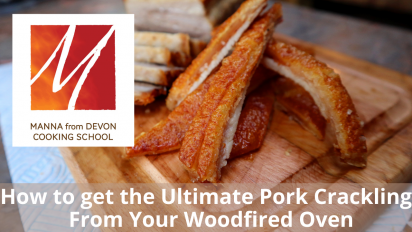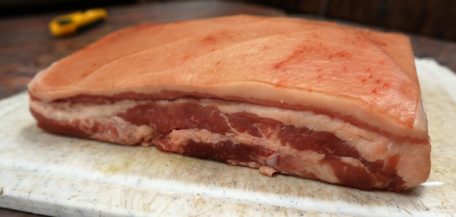How to get the Ultimate Pork Crackling from Your Woodfired Oven

In this Woodfired Workshop David is talking all things pork crackling and showing you how you can get consistently great results from roasting it in your woodfired oven. He’ll cover what joint to use, how to have your fire, what to do with your door, how to use a stanley knife if you need to rescore the skin. More on our youtube channel right here.
We’ve put together a few notes to so in no particular order –
- Take your joint our of any packaging overnight and leave on a tray or a plate in the fridge so the skin dries out.
- Use a Stanley knife to rescore the skin if you need to. Make sure it is only out a little way and work away from your body.
- Use a good fatty joint like belly pork or shoulder – much more forgiving than leg which can be dry.

A lovely piece of belly pork
- Rub some salt into the skin and the meat for seasoning.
- Don’t put anything else in the oven that will give off moisture. If you do want to make use of all the space, a sealed pan of red cabbage or of beans are good choices.
- Use a heat deflector to keep the oven tidy and prevent side scorch from the embers
- Keep the door slightly ajar to let out any moisture.
- If your crackling isn’t quite as puffed up as you’d like by the time the meat is cooked, refire the embers with some small pieces of wood to get some heat into the oven and then finish off the crackling for 5 minutes or so.
- Don’t cover the crackling with foil when it comes out of the oven. Take it off the joint and cover that so it can rest; chop up the crackling while it’s resting and resist the temptation to eat it all before you serve your dinner!
- Lots more on the video so do check it out!
- We usually cook belly pork on our Expertise course so if you’d like to see it in action, do join us. More info here.
Wine Suggestion
Roast pork is such a rich meat that you need something to really cut through it. Suzie from Michael Sutton’s Cellar has come up trumps again –
- White wine is really good with pork especially a Viognier but serve at 10 deg C (ie not too cold) to really taste it
- For a red I would go Pinot Noir, light-bodied fruity with the acidity that cuts through the richness of the meat.

